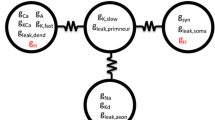Endogenous bursters in central pattern generators (CPGs) generate rhythmic firing patterns controlling regular movements in the organism. Based on a pacemaker kernel model of the stomatogastric ganglion (SGG) of crustaceans, we constructed three reduced models, (i) dendrite-reduced model (DRM), (ii) axon-reduced model (ARM), and (iii) primary neurite-reduced model (PNRM). Similar firing patterns were observed in two models except the axon-reduced one. Perturbing of various parameters in the models induced bifurcation phenomena in the occurrence of interspike intervals (ISIs), which depicted variation of the firing patterns. By comparing and analyzing two-dimensional parameter planes derived from the above different models, the effects of compartments on varying firing patterns were detected. In particular, a different kind of period-doubling transition mode of firing patterns, which varied via a ring-shape mode, was found.
Similar content being viewed by others
References
R. Nargeot, D. A. Baxter, and J. H. Byrne, “Contingentdependent enhancement of rhythmic motor patterns: an in vitro analog of operant conditioning,” J. Neurosci., 17, 8093-8105 (1997).
R. Nargeot, C. Petrissans, and J. Simmers, “Behavioral and in vitro correlates of compulsive-like food seeking induced by operant conditioning in Aplysia,” J. Neurosci., 27, 8059-8070 (2007).
D. K. Hartline and D. F. Russell, “Endogenous burst capability in a neuron of the gastric mill pattern generator of the spiny lobster Panulirus interruptus,” J. Neurobiol., 15, No. 5, 345-364 (1984).
H. M. Pinsker, “Aplysia bursting neurons as endogenous oscillators. I. Phase-response curves for pulsed inhibitory synaptic input,” J. Neurophysiol., 40, No. 3, 527-543 (1977).
S. Kater and C. R. S. Kaneko, “An endogenously bursting neuron in the gastropod mollusk, Helisoma trivolvis,” J. Comp. Physiol., 79, No. 1, 1-14 (1972).
R. M. Harris-Warrick and R. E. Flamm, “Multiple mechanisms of bursting in a conditional bursting neuron,” J. Neurosci., 7, No. 7, 2113-2128 (1987).
H. A. Lechner, D. A. Baxter, J. W. Clark, and J. H. Byrne, “Bistability and its regulation by serotonin in the endogenously bursting neuron R15 in Aplysia,” J. Neurophysiol., 75, No. 2, 957-962 (1996).
S. K. Maran, F. H. Sielin, K. Demla, et al., “Responses of a bursting pacemaker to excitation reveal spatial segregation between bursting and spiking mechanisms,” J. Comput. Neurosci., 31, No. 2, 419-440 (2011).
B. J. Norris, M. J. Coleman, and M. P. Nusbaum, “Pyloric motor pattern modification by a newly identified projection neuron in the crab stomatogastric nervous system,” J. Neurophysiol., 75, No.1, 97-108 (1996).
E. Marder and D. Bucher, “Central pattern generators and the control of rhythmic movements,” Current Biol., 11, No. 23, R986-R996 (2001).
R. M. Harris-Warrick and R. E. Flamm, “Multiple mechanisms of bursting in a conditional bursting neuron,” J. Neurosci., 7, No. 7, 2113-2128 (1987).
J. Golowasch, L. F. Abbott, and E. Marder, “Activitydependent regulation of potassium currents in an identified neuron of the stomatogastric ganglion of the crab Cancer borealis,” J. Neurosci., 19, No. 20, RC33 (1999).
J. Golowasch, F. Buchholtz, I. R. Epstein, and E. Marder, “Contribution of individual ionic currents to activity of a model stomatogastric ganglion neuron,” J. Neurophysiol., 67, No. 2, 341-349 (1992).
A. A. Prinz, V. Thirumalai, and E. Marder, “The functional consequences of changes in the strength and duration of synaptic inputs to oscillatory neurons,” J. Neurosci., 23, No. 3, 943-954 (2003).
S. K. Maran, F. H. Sieling, K. Demla, et al., “Responses of a bursting pacemaker to excitation reveal spatial segregation between bursting and spiking mechanisms,” J. Comput. Neurosci., 31, No. 2, 419-440 (2011).
L. Li, H. Gu, M. Yang, et al., “A series of bifurcation scenarios in the firing pattern transitions in an experimental neural pacemaker,” Int. J. Bifurcat. Chaos, 14, No. 5, 1813-1817 (2004).
Q. Lu, H. Gu, Z. Yang, et al., “Dynamics of firing patterns, synchronization and resonances in neuronal electrical activities: experiments and analysis,” Acta Mech. Sin., 24, No. 6, 593-628 (2008).
H. Gu, “Biological experimental observations of an unnoticed chaos as simulated by the Hindmarsh-Rose model,” PloS One, 8, No. 12, e81759 (2013).
R. Barrio and A. Shilnikov, “Parameter-sweeping techniques for temporal dynamics of neuronal systems: case study of Hindmarsh-Rose model,” J. Math. Neurosci., 1, No. 1, 1-22 (2011).
I. Samengo and M. A. Montemurro, “Conversion of phase information into a spike-count code by bursting neurons,” PloS One, 5, No. 3, e9669 (2010).
E. Mosekilde, B. Lading, S. Yanchuk, et al., “Bifurcation structure of a model of bursting pancreatic cells,” Biosystems, 63, Nos. 1/3, 3-13 (2010).
A. L. Hodgkin and A. F. Huxley, “A quantitative description of membrane current and its application to conduction and excitation in nerve,” J. Physiol., 117, No. 4, 500-544 (1952).
Author information
Authors and Affiliations
Corresponding author
Rights and permissions
About this article
Cite this article
Ye, W.J., Liu, S.Q. Roles of Cell Compartments in the Variation of Firing Patterns Generated by Reduced Pacemaker Models of the Crustacean Stomatogastric Ganglion. Neurophysiology 48, 78–85 (2016). https://doi.org/10.1007/s11062-016-9571-0
Received:
Published:
Issue Date:
DOI: https://doi.org/10.1007/s11062-016-9571-0




